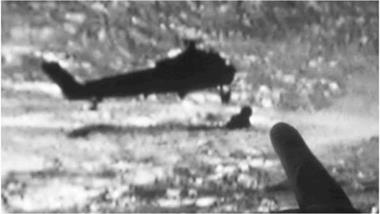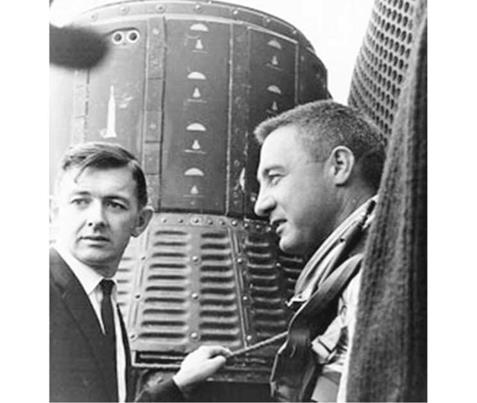A REVEALING POSSIBILITY
In the late 1990s, space historian Rick Boos conducted an extensive interview with Jim Lewis’s co-pilot John Reinhard. On being asked how far their helicopter Hunt Club 1 was from Liberty Bell 7 when the hatch suddenly blew out into the water, Reinhard responded, “We were actually about five feet away and maybe not even that far. We were hovering, just sitting there waiting in a hover, that’s all. Whether [Jim] considered ‘final’ as sliding over to [the capsule] I don’t know. Had we been further away we wouldn’t [have made the attempt], we would just have lost it and started the harness down and picked [Gus] up.”
As to Reinhard’s own version of what happened, he told Boos, “There was very little happening on final approach. We were in a hover, waiting on Gus to complete what he had to do inside the cockpit. We were ready anyway. I had what you call a ‘cookie cutter’ all ready to go, which was the antenna snipper. Gus said he was ready and we slid over, and when I touched the antenna there was an [electrostatic] arc. The cookie cutter had two blades on it with two explosive squibs and both of them had gone off without my activating them, and they were on two separate switches! So whatever it was that caused the arc set them both off; and fortunately the antenna was inside the yoke on it and snipped it and cut it off. At the same time that’s when I was aware that Gus was coming out.”
Asked if he actually saw the hatch go, Reinhard replied, “I just saw a flash and Gus came out. [The hatch] went out to the end of the lanyard and kept going. It was right after I cut the antenna.” He also told Boos that Capt. Phil Upschulte (who died in April 2012) and Lt. George Cox saw it all happening from Hunt Club 2.
The next question was an obvious one. “So it was when you cut the antenna that the hatch blew?”
Reinhard answered without hesitation, “Right! When I touched the antenna there was an arc and both cutters fired. At that same time, the hatch came off. It could be that some static charge set it off.”25
There is a noteworthy precedent to Reinhard’s story, as told by Peter Armitage, an AVRO engineer working with NASA’s Space Task Group and project manager for the Mercury capsule air drop tests. Armitage was tasked with finding a safe and manageable means of recovering Mercury space capsules from the water. As doing so from a
|
Although indistinct and taken from a long range, this dramatic still from footage of the recovery attempt is one of a sequence that actually shows the hatch blowing and flying away from Liberty Bell 7 just as John Reinhard attempts to cut the HF aerial. In this still, the hatch is shown at the top of its shallow arc just above the end of the investigator’s index finger. (Photo: Rick Boos, taken from NASA film footage) |
|
Peter Armitage (left) with Gus Grissom during a spacecraft recovery exercise. (Photo: NASA) |
Navy destroyer in generally rolling or choppy seas could be an extremely difficult task, helicopter recovery became the preferred option. But there was one obstacle to overcome, namely the telescoping HF antenna that extended out 22 feet above the spacecraft as a radio recovery aid.
“It started out, aluminum of about an inch or so [in diameter] and ended up just a thin antenna at the top. But when we flew in with a helicopter, [the antenna] was so high up that you couldn’t get close enough because it might hit the rotor blades. And the helicopter guy had to come in with what amounts to a shepherd’s crook and hook onto the spacecraft and then get the big hook in and pull it all out.
“Milt Windler and I started thinking about that problem, and we got some money out of petty cash… went down to the hardware store in Hampton and we bought two things. We bought a tree pronged pruner. They’re saws on the end of a pole. And we bought just a pole tree pruner, the little thing that lops off limbs. I still have it. It’s at home. I use it still.
“We did a few tests to see if we could cut through [the antenna]. Well, of course, the dynamics were terrible, because the helicopter was doing this and the spacecraft [was] waving around. It was really difficult. So Bob [Thompson] said one day,
‘Why don’t you go up to the naval ordnance place at Dahlgren, Virginia.’ It was just north of Hampton… So I took off one day on my own, talked to the people to see if they could put an explosive charge in this tree pruner so that once you got onto it, instead of having to pull a rope, which took too much time, that you’d press a button and the antenna would [be sliced off]. They took that project and what they produced was a great thing, and then we tested that and it worked fine. The helicopter would first fly in to the antenna, put this thing [against it], press a button, lop off the antenna, and then they could go in and pick [the capsule] up.
“Interesting story there. We had sent this [cutter] to the New River Marine Base, the big Marine base [in North Carolina] where all the helicopter support came from. We sent it down there and they had played around with it. They had put a Mercury boilerplate out with the antenna, not in the water initially but just on the land, then flown in, cut the antenna off, picked it up.
“We were using HR-2S twin-engine helicopters, big helicopters, single-blade, twin-engine. You could reach out of the front of it. In fact, we designed and built a catamaran that was nothing more than a structure with rails that stuck right out of the front of the [helicopter], with a little basket on it, something like you see guys going up telephone poles with. And here you’ve got this big helicopter behind you. So we had produced this, and they’d done some tests. I went down to witness a test of this new system we designed… They said, ‘Would you like to do it?’ and I said ‘Fine.’
“So here I am, strapped on the end of this flimsy-looking thing with this gigantic helicopter behind me, and they gave me the electronic tree-pruning device in my hands, and they flew around the field and flew in to the boilerplate spacecraft with the antenna. As soon as I touched the thing to the antenna, my hands went up like that. There’s a big static shock [produced by the spinning rotor]. I looked behind and there’s all these Marines laughing their heads off. Of course, you needed big gloves. They were just having fun, you know. But just terrible.”26












